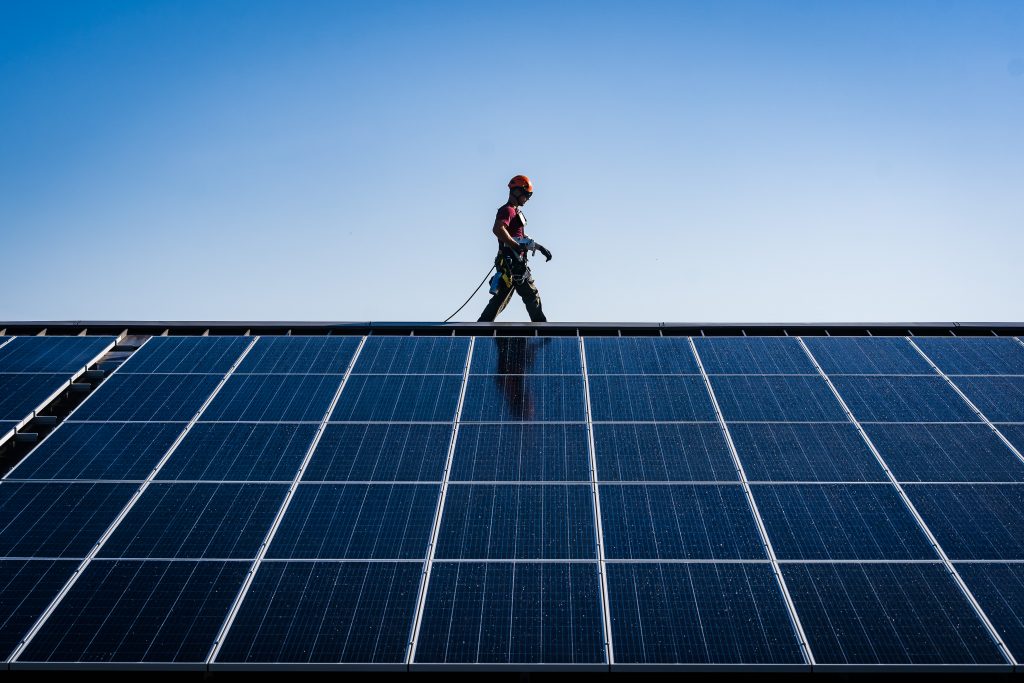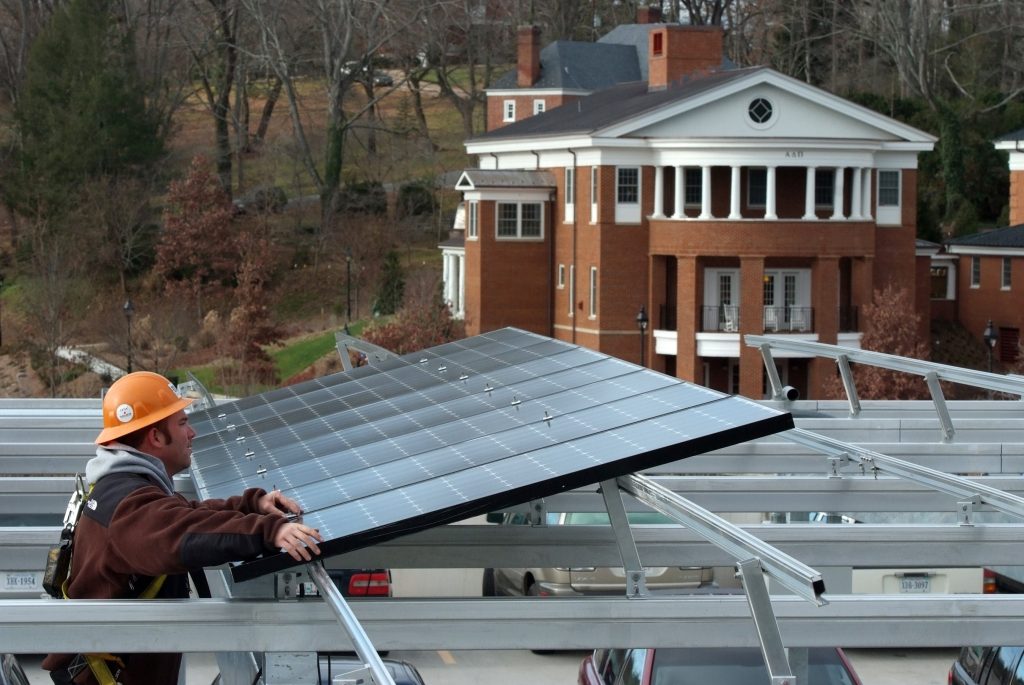Nov 12, 2020
We’re A Solar Company. And We’re Telling You Not to Cover Your Whole Roof With Solar Panels.
When people think of getting rooftop solar, their first thought may be the more the better. This sounds like common sense. More solar panels will generate more clean energy and that can mean more savings on electricity. But that’s not always the case, and sometimes when installing solar panels less can actually be more.

If you are considering going solar at your school, hospital or business, you probably want to do your part to help the environment. You may also like that solar creates good jobs and boosts America’s energy independence.
But in the end, you’ll want to get the maximum benefit for any investment you make in solar power.
You can certainly buy your own solar panels. Traditionally, this was the only option for organizations that wanted to get solar power on site. But having to buy your own equipment brought high upfront cost and the hassle of operating and maintaining your own solar system. These were major barriers for many organizations that want to go solar.
That’s why so many commercial solar customers today are taking advantage of modern financing. Specifically, power purchase agreements (PPAs) that allow an organization to get solar on site for no upfront capital cost.
Under a PPA, the solar company installs the panels at your location. It then continues to own and operate the solar power system for the term of the solar agreement, typically for 20 to 25 years. Simultaneously, the company sells the power from the panels to you, nearly always at a discount over utility power.
A PPA is a great way to get solar more affordably. But it can confuse the economics a bit unless you understand how solar companies bill their customers under a PPA.
Even in a PPA, You Still Pay the Cost of Getting Too Many Solar Panels

When the only option to go solar onsite was to buy your own equipment, the consequences of overbuilding your solar power system were clear. After a certain point, buying more solar panels brings diminishing returns. And if you’re stuck with the bill for equipment, you’re going to shop more carefully.
By contrast, if you’re getting solar power through a PPA and the solar company is paying for the panels, then it may seem like there’s no downside for you in getting as many panels installed as possible.
But as with everything in business, when it comes to solar PPAs, there’s no such thing as a free lunch.
It’s true that under a PPA you don’t pay for solar panels upfront because your solar company buys and owns the panels at your location. But, if they overbuild your solar power system, the company will pass along the extra costs to you by charging you for power you don’t need, thus reducing your effective savings. In this case, less is more. This is especially the case for customers on peak demand electric tariffs, where 60% to 75% of the energy bill may be in the form of peak demand charges, not the electricity usage charges.
And even a few kilowatts overbuilt can add up to big costs over the 25-30 year term typical for a PPA. You could be locked in for two or three decades to costs that are higher than they should be.
Net Zero? Admirable but Impractical for Most Solar Customers

Going net zero in your use of power from fossil fuels and grid energy is an admirable goal. But it’s almost never economic to install solar panels on site to replace 100% of the power from your utility.
The right amount of solar is usually not the maximum number of panels that will cover your roof or available space on the ground.
Until the price of batteries comes down enough to make it worthwhile to replace all your utility power with 100% solar energy, it will always be cheaper to plan to use some combination of grid power and rooftop solar.
A typical mix to deliver the biggest savings on your electric bill, especially if your facility is on a peak demand electric tariff rate, will range from 30% to 70% solar power. With this, the rest of your power will continue to come from your electric utility.
A solar panel company that wants to cover your entire surface area may be only looking for a big sale. They probably won’t be looking out for your best interest.
For most customers, the right amount of solar is the minimum number of panels that will give you the maximum amount of savings.
To calculate the right amount of solar panels that will hit the savings sweet spot, you need to analyze your typical power usage over a year in light of your utility’s rate structure.
A key factor is whether your utility increases your base power rate or adds additional charges for “peak demand.” Such demand charges can raise your whole electric bill based on your highest instance of usage in a billing cycle.
Are you confused yet?
It Takes Expertise to Advise on the Best Value
Understanding commercial electricity bills, utility rate schedules and demand charges can be complicated. A good solar company will be able to analyze your bill for you. Also, they’ll recommend how to get the most bang for your solar buck within the rate schedule that your utility has assigned to your account.
Only after doing that analysis will a knowledgeable and conscientious solar company recommend a certain amount of solar panels for your roof to maximize your savings.
And that optimal number of panels will almost never cover your entire available surface area.
If a solar installer gives you a proposal that would cover your roof in solar panels, the large amount of blue or black squares in the engineering diagrams representing photovoltaic panels may look impressive. Wow, that sure is a lot of solar!
But you should ask: Is it really in your best interest to build that big? Or is the solar company just trying to make money by selling you more solar panels than you really need?
Some solar companies put their own interest above their customers’ interest by trying to sell as many panels as possible.
In particular, some solar engineering, procurement, and construction (EPC) companies that maintain a large number of solar installers permanently on staff will want to keep their crews busy. So, the more panels they install, the busier their crews will be. We have seen proposals from EPC companies proposing twice as many solar panels for a roof than what would represent the best value for the customer. Schemes like this happen to the point where had the customer gone with that proposal, they would have incurred significant losses in revenues.
By contrast, Secure Futures hires installers only when needed. This means we have more flexibility to gear our business to the needs of our customers.
Getting the Size Right for Your Needs

Any trustworthy solar company will always put the interest of the customer first, starting with their financial interest. And that might mean actually selling you less solar than some other companies would.
A good solar company knows that a satisfied customer enjoying savings over the long run is worth more than a a big one-time sale that might go sour after a few months.
For Secure Futures, offering the best value, and not necessarily the most solar panels, is just good business. It’s why customers choose our proposals over the competition. And it’s why so many of our customers come back to us for a second or third round of solar projects.
Providing honest pricing and installing solar energy systems at the right scale are part of our special commitment to a triple bottom-line of profit, people and planet. That’s why Secure Futures became a Certified B Corp in 2017. B Corp certification is to business what Fair Trade certification is to coffee or USDA Organic certification is to milk. Read more about how our B Corp commitment influences our business here.
There’s no one-size-fits-all answer to sizing a solar power system for a school, a hospital or a business. Every commercial solar customer is different.
Before signing up for a PPA, make sure that your solar company understands your situation well enough to give you the best recommendation on the size of a solar project — and that the solar company is willing to put your need for maximum value before their need for a big sale.